Week 3 - Neurons: Structure, Action Potentials, Membrane Potentials, Synaptic Transmission L7 and L8
1/65
There's no tags or description
Looks like no tags are added yet.
Name | Mastery | Learn | Test | Matching | Spaced |
|---|
No study sessions yet.
66 Terms
What are the two main types of cells in the nervous system?
Neurons and Glial Cells
What are the three types of neurons?
Sensory neurons, Motor neurons, and Interneurons
What is the primary function of neurons?
To collect, process, and elicit responses to information
What are the main structural components of a motor neuron?
Cell body, dendrites, single axon, myelin sheath, nodes of Ranvier, synaptic terminals
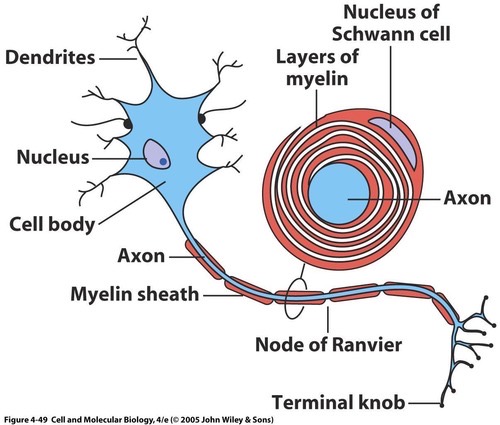
What is the role of dendrites in a neuron?
To collect electrical signals and conduct them to the cell body.
What is the function of the axon in a neuron?
To conduct action potentials from the axon hillock to the axon terminal.
What occurs at the axon terminal?
It forms synapses with other cells and releases neurotransmitters into the synaptic cleft.
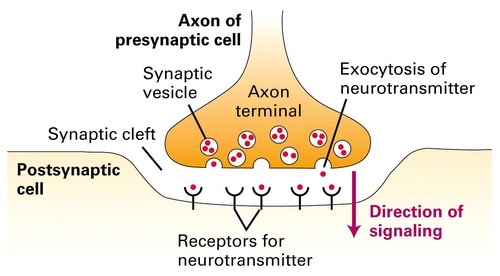
What is membrane potential?
An electrical charge difference across a neuron's plasma membrane.
How is resting potential defined in neurons?
The voltage across the plasma membrane when the neuron is at rest, typically around -70mV.
What ions are primarily involved in maintaining resting potential?
High intracellular concentration of K+ and low intracellular concentrations of Na+ and Cl-.
What is the role of the Na+/K+-ATPase pump?
To import K+ ions and export Na+ ions, maintaining the negative resting potential inside the neuron.
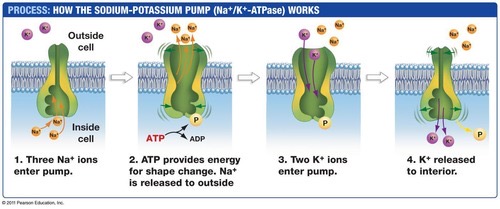
What is action potential?
A rapid sequential change in membrane potential used by neurons to conduct signals.
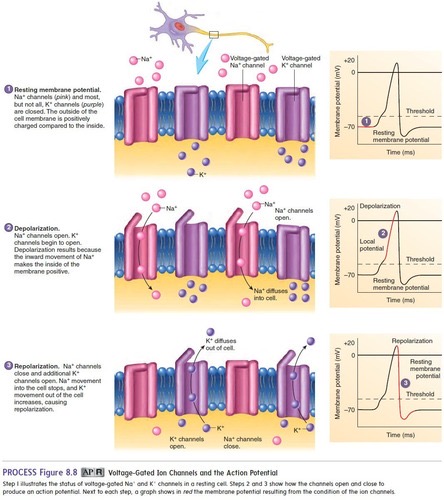
What triggers the action potential in a neuron?
A stimulus that causes some Na+ channels to open, leading to depolarization.
What happens during the depolarization phase of an action potential?
Na+ influx causes the interior of the cell to become more positive.
What occurs after the peak of an action potential?
Na+ channels close, K+ channels open, and K+ rushes out, repolarizing the cell.
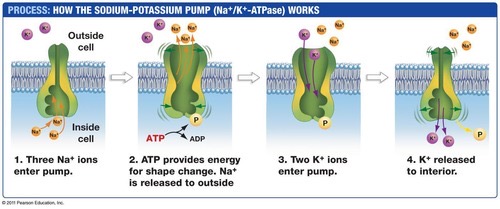
What is the significance of the equilibrium potential for K+?
It is the voltage at which the concentration gradient for K+ out of the cell balances the electrical gradient pulling K+ in.
What technique did Erwin Neher and Bert Sakmann develop?
Patch clamping, which allows for the study of currents through individual ion channels.
What is the typical measurement of membrane potentials in neurons?
About 70-80 mV, expressed as inside-relative-to-outside.
What happens when the membrane's permeability to ions changes?
The membrane potential changes, which can lead to action potentials.
What are voltage-gated ion channels?
Channels that open or close in response to changes in membrane potential, facilitating action potentials.
What is the role of neurotransmitters in neuron communication?
They are released from the presynaptic cell and bind to receptors on the postsynaptic cell, triggering responses.
What causes the inside of a neuron to become negatively charged?
The movement of K+ ions out of the cell through leak channels.
What is the threshold potential for triggering an action potential?
-50mV, which must be reached for the action potential to occur.
What is the sequence of events during an action potential?
Resting state, depolarization, repolarization, and return to resting state.
What restores the membrane potential after an action potential passes?
The Na+/K+ pump restores the membrane potential.
What is the short refractory period in relation to action potentials?
The refractory period is a short time during which ion channels are unresponsive to depolarization.
What does the term 'all or none event' mean in the context of action potentials?
It means that action potentials occur fully or not at all, regardless of the strength of the stimulus.
How does the influx of Na+ ions affect the propagation of action potentials?
The influx of Na+ ions causes positive charges to spread away from sodium channels, leading to the depolarization of adjacent membrane areas.
What role do voltage-gated Na+ channels play in action potential propagation?
They open in response to depolarization, allowing Na+ ions to enter and propagate the action potential.
What is the significance of the myelin sheath in neuronal signaling?
The myelin sheath acts as electrical insulation, allowing signals to travel faster by jumping from node to node.
What is the speed of action potential propagation in myelinated axons compared to unmyelinated axons?
In myelinated axons, action potentials can travel at speeds of up to 150 m/sec, while in unmyelinated axons, speeds are around 5 m/sec.
What is a node of Ranvier?
A node of Ranvier is an unmyelinated section of the axon with a high concentration of voltage-gated Na+ channels, facilitating rapid action potential propagation.
How does axon diameter affect action potential speed?
Larger axons transmit action potentials faster due to less current leakage compared to smaller axons.
What is multiple sclerosis and how does it affect neuronal function?
Multiple sclerosis is a disease that damages myelin, impairing electrical signaling and leading to muscle weakness and coordination issues.
What is the effect of neurotoxins on neuron function?
Neurotoxins can block voltage-gated channels, preventing action potentials without affecting resting potential.
How do local anesthetics like procaine work?
They close ion channels in sensory cells and neurons, preventing action potentials and blocking pain signals to the brain.
What occurs at the synapse when an action potential arrives?
Neurotransmitters are released from synaptic vesicles into the synaptic cleft, transmitting information between neurons.
What is the role of calcium ions in synaptic transmission?
Calcium ions enter the presynaptic cell, triggering synaptic vesicles to fuse with the membrane and release neurotransmitters.
What initiates an action potential in the postsynaptic cell?
Neurotransmitters bind to receptors on the postsynaptic membrane.
What happens to neurotransmitters after they trigger a response?
They are broken down and taken back up by the presynaptic cell.
What is the role of excitatory neurotransmitters?
They open Na+ channels, triggering an action potential in the receiving cell.
What is the role of inhibitory neurotransmitters?
They open channels for ions like Cl- and K+ that decrease the tendency to develop an action potential.
What criteria must a molecule meet to qualify as a neurotransmitter?
It must be present at the synapse, released in response to an action potential, bind to a receptor on a postsynaptic cell, and be taken up or degraded.
What are ligands in the context of neurotransmitters?
Ligands are molecules that bind to a specific site on a receptor molecule.
How does a neurotransmitter's binding to a ligand-gated ion channel affect the postsynaptic cell?
It transduces the chemical signal into an electrical signal, changing the membrane potential of the postsynaptic cell.
What is the significance of the electrochemical gradient in neurotransmission?
It drives the flow of ions when channels open, influencing the action potential in the postsynaptic cell.
What is the effect of neurotransmitter degradation?
It ends the response initiated by the neurotransmitter at the synapse.
What is the relationship between neurotransmitters and receptors?
Neurotransmitters bind to receptors on postsynaptic cells to elicit a response.
What occurs if the threshold potential is reached in the postsynaptic cell?
An action potential is initiated.
What are neurotransmitters?
Small nitrogen-containing organic molecules that transmit signals in the nervous system.
What is the role of neurotransmitters in relation to second messengers?
Some neurotransmitters bind to receptors that activate enzymes for the production of second messengers, which may trigger changes in gene expression, enzyme activity, or membrane potential.
What neurotransmitter is known for stimulating skeletal muscle contraction?
Acetylcholine
What are biogenic amines?
A class of neurotransmitters that includes adrenaline, noradrenaline, serotonin, and dopamine.
How does dopamine affect mood and movement?
An imbalance in dopamine can lead to conditions such as Parkinson's disease (lack of dopamine) and schizophrenia (excess of dopamine).
What neurotransmitters are associated with depression?
Reduced levels of noradrenaline and serotonin.
What are the two modes of neurotransmitter removal from the synapse?
- Enzymatic destruction (e.g., acetylcholinesterase) 2. Reuptake by proteins transporting neurotransmitter molecules back to presynaptic terminals.
What is the function of gamma-aminobutyrate (GABA)?
GABA serves as an inhibitory neurotransmitter, and its activity is enhanced by general anesthetics and medications like Valium.
What is MPTP and its significance in neuroscience?
MPTP is a toxic chemical that causes structural damage to neurons and is a causative agent in Parkinson's disease.
What are the hallmark symptoms of Parkinson's disease?
Slowed movement, rigidity, and tremors.
What structural effects can toxic substances have on neurons?
Demyelination, axonopathy, and neuronopathy.
How do amphetamines affect neurotransmitter release?
Amphetamines stimulate excessive release of dopamine.
What is the mechanism of cocaine in the brain?
Cocaine interferes with the reuptake of dopamine, leading to sustained presence and effects in the limbic system.
What is the function of SSRIs?
Selective serotonin reuptake inhibitors block the removal of serotonin from synapses, prolonging its effect in receiving cells.
What is Ritalin and its use?
Ritalin (methylphenidate) is used to treat ADHD and blocks the reuptake of dopamine and noradrenaline.
How does alcohol affect neurotransmission?
Alcohol increases the inhibitory effects of GABA.
What is synaptic dysfunction and its associated conditions?
Synaptic dysfunction can lead to disorders such as Parkinson's disease, schizophrenia, depression, and Alzheimer's disease.